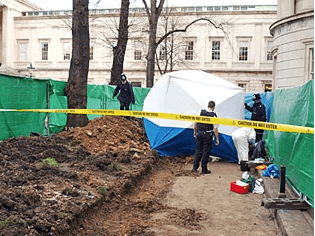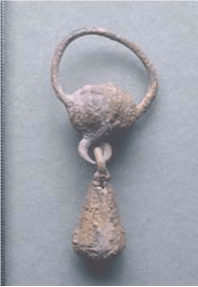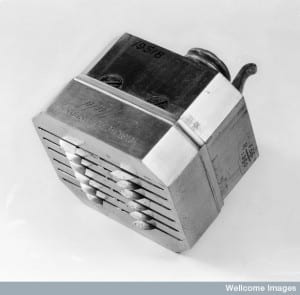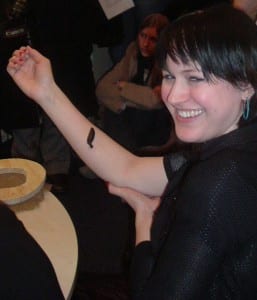Constantly Changing, Ever Evolving. HIV: Adapting to Change
By Gemma Angel, on 30 July 2012
 by Alicia Thornton
by Alicia Thornton
As someone whose background is in biological sciences, working in the Grant Museum of Zoology feels a little like coming home. Robert Edmond Grant collated the collection for the teaching of comparative anatomy and zoology, showing the differences and similarities between species. The collection is hugely diverse; from sponges and other marine invertebrates (in which Grant held a particular interest) to skeletons of primates, elephants, big cats and other mammals. The collection even has examples of some animals which are now extinct. Most notable are the quagga, a zebra-like creature from Southern Africa which was hunted to extinction in the wild around the time that Grant was teaching at UCL; and the thylacine or Tasmanian tiger. The thylacine was a marsupial native of Australia, also hunted to extinction, during the early 20th century. The museum also has bones from a Dodo, which died out as the result of a combination of factors, including hunting and predation by imported species introduced by European settlers.
For me, what the collection shows so well, through its diversity, is how every organism is adapted to the environment in which they live. Each species or subspecies has evolved to have a unique way of living and their biology gives a complete illustration of this. For example, the shape of a jaw indicating the type of diet an animal has, or the dimensions of the limbs showing how an animal may swing through trees or stalk prey in grassland. As I near the end of the first year of my PhD, I find that it is sometimes easy to get too engrossed in the details of my research and lose sight of what interested me about the topic in the first place. The Grant museum serves as a perfect reminder. My own research is focused on infectious diseases, and specifically human immunodeficiency virus (HIV). The way in which the virus has evolved and continues to evolve has been one of the biggest challenges for scientists and medics working in HIV treatment, care and research.
Like all viruses, HIV requires a living cell to reproduce. During infection, the virus enters the human cells and uses the machinery of the host cell to replicate, producing further infectious particles and releasing them to continue the infection cycle. In order to be successful and survive, the virus must find mechanisms by which it can evade the response of the host immune system that is designed to eliminate it. In fact, HIV is perfected suited to this; having the ability to infect cells which constitute a key component of the immune system as well as those which are out of the reach of the immune system.
Due to the nature of its replication, HIV evolves particularly fast and thus has the ability to survive changing environments.[1] A huge range of drugs to treat HIV have been developed since the beginning of the epidemic. These drugs have been a huge success, allowing people to live much healthier lives. Where they are readily available they have dramatically reduced the numbers of people who develop AIDS[2] and increased life expectancy of HIV positive individuals to almost that of HIV negative individuals[3]. Yet they never eliminate the virus completely and as new drugs are introduced, the virus rapidly evolves, giving rise to drug resistant strains and making treatment even more challenging.[4]
 The 19th International AIDS conference was held in Washington DC, USA in July 2012. This is the largest of the HIV conferences with over 20,000 delegates, taking place every two years, and is attended by a mix of medics, nurses, public health professionals, advocacy groups and policy makers. Finding a cure for HIV was a key theme of the conference and like all HIV conferences, a large volume of work presented was focused on the development of new drugs and drug combinations. Increasing the range of drugs available means that doctors are more able to combat the development of drug resistance and keep their patient’s viral replication supressed.
The 19th International AIDS conference was held in Washington DC, USA in July 2012. This is the largest of the HIV conferences with over 20,000 delegates, taking place every two years, and is attended by a mix of medics, nurses, public health professionals, advocacy groups and policy makers. Finding a cure for HIV was a key theme of the conference and like all HIV conferences, a large volume of work presented was focused on the development of new drugs and drug combinations. Increasing the range of drugs available means that doctors are more able to combat the development of drug resistance and keep their patient’s viral replication supressed.
The extent of the HIV epidemic is the result of a complex combination of social and scientific factors. However, there is no doubt that the virus’ ability to continually change and adapt to the environment in which it survives is a one of the key reasons that the infection remains such a challenge to control.
[1] Rambault A, Posada D, Crandall KA & Holes EC. The Causes and Consequences of HIV Evolution. Nature Reviews Genetics 2004; 5(1): 52-61.
[2] Mocroft A, Ledergerber B, Katlama C, Kirk O, Reiss P, d’Arminio Monforte A, Knysz B, Dietrich M, Phillips AN, Lundgren JD; EuroSIDA study group. Decline in the AIDS and death rates in the EuroSIDA study: an observational study. Lancet. 2003; 362(9377):22-9.
[3] Nakagawa F, Lodwick RK, Smith CJ, Smith R, Cambiano V, Lundgren JD, Delpech V, Phillips AN. Projected life expectancy of people with HIV according to timing of diagnosis. AIDS. 2012; 26(3):335-43.
[4] UK Collaborative Group on HIV Drug Resistance; UK CHIC Study Group. Long-term probability of detecting drug-resistant HIV in treatment-naive patients initiating combination antiretroviral therapy. Clin Infect Dis. 2010; 50(9):1275-85.
 Close
Close











